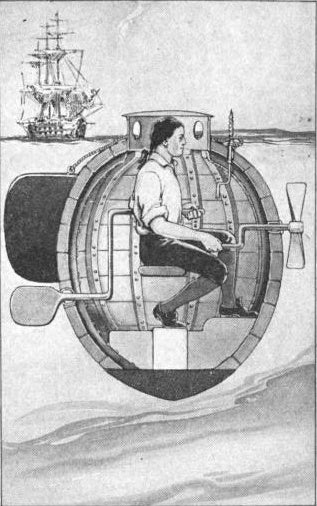On July 1, 2019, a fire on a Russian nuclear-powered submarine in the Barents Sea killed fourteen of the crew. According to Russian sources, they died preventing a “catastrophe of global proportions.” The nature of that catastrophe was not specified, but it’s hard not to be hyperbolic when reactor meltdowns or explosions are worst-case scenarios.
The Losharik’s mission was top secret. Submarines do tend to evade attention; that’s their tactical advantage. Hundreds of them are deployed around the world. At least forty nations have one in their fleet.
Where did these monsters of the deep come from? Frank Uhlig, Jr., special projects editor at the U.S. Naval Institute, has written a somewhat surprising history of submarine origins. He reveals that the U.S. Navy, which led modern submarine development, acquired its first sub in 1900. The first submersible used in combat, however, pre-dated this by 124 years.
During the American Revolutionary War, inventor David Bushnell and mechanical wizard Isaac Doolittle put together that first submersible, the Turtle. It was a thing of Connecticut Yankee ingenuity: essentially an oak barrel with clockwork mechanics that used water ballast to control its depth. With volunteer Ezra Lee hand-cranking the propeller, the Turtle set out to blow up the British Navy’s flagship in New York Harbor in 1776.

After fighting the tide for two hours to get to the HMS Eagle, Lee couldn’t attach his mine to the enemy vessel. A later effort further up the Hudson River also failed. (Artist Duke Riley created a submersible that paid homage to the Turtle‘s adventure in 2007; authorities were not amused when his submersible approached the Queen Mary II not so far from the site of the original would-be attack.)
The failure seemed to have lasting repercussions. In the early 1800s, when steamboat pioneer Robert Fulton tried selling a submarine to the British to use against the French, they told him to go away. When he tried selling it to the French, Napoleon wouldn’t talk to him. After the curious case of the Turtle, the development of submarine warfare was somewhat dormant for eight decades.
Then, in 1864, the Confederate States of America ship Hunley, with nine men aboard, successfully sank the USS Housatonic during the blockade of Charleston, South Carolina. Like the Turtle, the Hunley was powered by hand-cranking. Its weapon was a spar torpedo, an explosive device attached to a long pole. Five members of the Housatonic’s crew died in the attack. But also, every man on the Hunley perished. Submarines were proving to be deadly, in a variety of ways.
Weekly Newsletter
Uhlig writes that in the late nineteenth century and early twentieth century, John Holland’s use of a gasoline engine and diving planes put the U.S. at the forefront of modern submarine technology. The first United States Navy sub was named Holland in his honor. On the eve of World War I, the U.S. had thirty submarines. Britain had seventy-three; France fifty-five; Russia twenty-two. German had twenty-eight, a number which would quickly grow. World War I saw more ships sunk by submarines than by surface ships. Unrestricted submarine warfare waged by the Imperial German Navy, including the sinking of many merchant ships, was one of the factors drawing the U.S. into the war.
All technologies of warfare inspire counter-measures. Depth-charges, sonar, and the convoy system, in which groups of merchant ships are protected by a screen of warships, all emerged from WWI. Countermeasures are, of course, met with further counter-countermeasures. A century after WWI, submarines still prowl the deeps, while ways of fighting them follow hard on their underwater heels.







